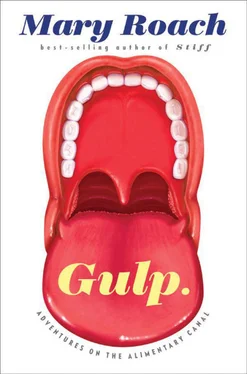For two people so firmly distanced by class and employment structure, Beaumont and St. Martin inhabited a relationship that could be oddly, intensely intimate. “On applying the tongue to the mucous coat of the stomach, in its empty, unirritated state, no acid taste can be perceived.” [36] Using the tongue is less peculiar than it seems. Before doctors could ship patients’ bodily fluids off to labs for analysis, they sometimes relied on tongue and nose for diagnostic clues. Intensely sweet urine, for instance, indicates diabetes. Pus can be distinguished from mucus, wrote Dr. Samuel Cooper in his 1823 Dictionary of Practical Surgery, by its “sweetish mawkish” taste and a “smell peculiar to itself.” To the doctor who is still struggling with the distinction, perhaps because he has endeavored to learn surgery from a dictionary, Cooper offers this: “Pus sinks in water; mucus floats.”
The one image I eventually found of Alexis St. Martin as a whole young man is in a painting by Dean Cornwell entitled Beaumont and St. Martin —part of the Pioneers of American Medicine series commissioned in 1938 by Wyeth Laboratories for an ad campaign. Despite the unfortunate side-parted bob that St. Martin appeared to stick with all through his adult life, the man as Cornwell rendered him is striking: broad cheekbones, vertically plunging aquiline nose, and a firmly muscled, deeply tanned chest and arms. Beaumont is dashing but dandified. His hair is oddly waved and piled, like something squeezed from a cake decorator’s bag.
Cornwell’s painting is set at Fort Crawford, in Michigan Territory, during St. Martin’s second stint in Beaumont’s employ, around 1830. At this stage in his digestive explorations, Beaumont had been trying to determine whether the gastric juice would work outside of the stomach, removed from the body’s “vital force.” (It does.) He filled vial after vial with St. Martin’s secretions and dropped in all manner of foods. The cabin became a kind of gastric-juice dairy. Beaumont, in the painting, holds one end of a length of gum elastic tubing in St. Martin’s stomach; the other end drips into a bottle in Beaumont’s lap.
I spent a good deal of time staring at this painting, trying to parse the relationship between the two. The gulf between their stations is clear. St. Martin wears dungarees worn through at the knees. Beaumont appears in full military dress—brass-buttoned jacket with gold epaulettes, piping-trimmed breeches tucked into knee-high leather boots. “True,” Cornwell seems to be saying, “it’s an unsavory situation for our man St. Martin, but look, just look, at the splendorous man he has the honor of serving.” (Presumably Cornwell took some liberties with the costuming in order to glorify his subject. Anyone who works with hydrochloric acid knows you don’t wear your dress clothes in the lab.)
The emotions are hard to read. St. Martin appears neither happy nor aggrieved. He lies on his side, propped on an elbow. His posture and far-off stare suggest a man reclining by a campfire. Beaumont, admirably erect, sits in a buckskin chair by the bed. He stares into high middle distance, as though a TV set were mounted on the cabin wall. He looks like a hospital visitor who has run out of things to say. The prevailing mood of the painting is stoicism: one man enduring for the sake of science, the other for subsistence. Given the painting’s intent—the glorification of medicine (and Beaumont and Wyeth labs)—it’s fair to assume the emotional content has been given a whitewash. It can’t have been a hoot for either. At least once in his notes, Beaumont mentions St. Martin’s “anger and impatience.” The procedure was not merely tedious; it was physically unpleasant. The extraction of the gastric juices, Beaumont wrote, “is generally attended by that peculiar sensation at the pit of the stomach, termed sinking, with some degree of faintness, which renders it necessary to stop the operation.”
The disrespect displayed by Beaumont and the medical establishment—evident in their correspondences about St. Martin—can’t have helped. St. Martin was referred to as “the boy” well into his thirties. He was “the human test tube,” “your patent digester.” For the out-of-body digestion experiments, Beaumont had St. Martin hold vials of gastric juice under his arms to simulate the temperature and movements of the stomach. “Kept in the axilla and frequently agitated for one hour and half,” Beaumont’s notes read. If you’d never heard the term axilla , you’d think it was a piece of laboratory equipment, not a French Canadian’s underarm. Beaumont carried out dozens of experiments that required St. Martin to hold vials this way for six, eight, eleven, even twenty-four (corn kernel!) hours. Not surprisingly, St. Martin twice quit—“absconded,” as Beaumont termed it—partly to see his family in Canada, but also because he’d had enough. Only the second time did he do so in violation of a signed contract, and for this he earned Beaumont’s lasting ire. In a letter to the U.S. surgeon general composed around that time, Beaumont deplores St. Martin’s “villainous obstinacy and ugliness.”
But Beaumont had no other fistulous stomach to turn to. Though he’d finished his experiments, he needed St. Martin to bolster his status overseas. Late in his career, he’d come to know a group of scientists in Europe—chemists and others to whom he’d shipped [37] The shipping of bodily fluids was a trying business in the 1800s. One shipment to Europe took four months. Bottles would arrived “spilt” or “spoilt” or both. One correspondent, taking no chances, directed Beaumont to ship the secretions “in a Lynch & Clark’s pint Congress water bottle, carefully marked, sealed and capped with strong leather and twine, cased in tin, with the lid soldered on.”
bottles of gastric juice for analysis. (His correspondence from that period is a mix of ghoulishness and high manners. “I thank you very much for your Bottle of the gastric fluid.” “I have… with peculiar pleasure experimented upon the masticated meat…, as suggested in your last letter.”) Though none of these men successfully identified the various “juices,” one had invited him to lecture in Europe, with St. Martin along as a kind of human PowerPoint.
What ensued was a game of Coyote and Roadrunner that dragged on for more than a decade. Sixty letters went back and forth among Beaumont, St. Martin, and various contacts at the American Fur Company who had located St. Martin and tried to broker a return. It was a seller’s market with a fevered buyer. With each new round of communications—St. Martin holding out for more or making excuses, though always politely and with “love to your family”—Beaumont raised his offer: $250 a year, with an additional $50 to relocate the wife and five children (“his live stock,” as Beaumont at one point refers to them). Perhaps a government pension and a piece of land? His final plan was to offer St. Martin $500 a year if he’d leave his family behind, at which point Beaumont planned to unfurl some unspecified trickery: “When I get him alone again into my keeping I will take good care to control him as I please.” But St. Martin— beep, beep! —eluded his grasp.
In the end, Beaumont died first. When a colleague, years later, set out to bag the fabled stomach for study and museum display, St. Martin’s survivors sent a cable that must have given pause to the telegraph operator: “Don’t come for autopsy, will be killed.”
BY TODAY’S STANDARDS of political correctness, William Beaumont had an unattractive sense of entitlement and superiority. I don’t see this as a product of flawed morals. After all, this is a man who claimed, in his diary, to be following Benjamin Franklin’s “plan for attaining moral perfection.” I see it, rather, as a product of nineteenth-century class structure and the larval state of medical ethics. The medical establishment of the day didn’t concern itself greatly with issues of informed consent and the rights of human subjects. It wouldn’t have occurred to people back then to condemn William Beaumont for exploiting a “porkeater” to advance scientific knowledge or his own career. St. Martin was compensated, they’d point out; he was never held against his will. Beaumont was judged solely on his contributions and commitment to physiology. He was, and remains, a lauded figure in the history of medicine.
Читать дальше












